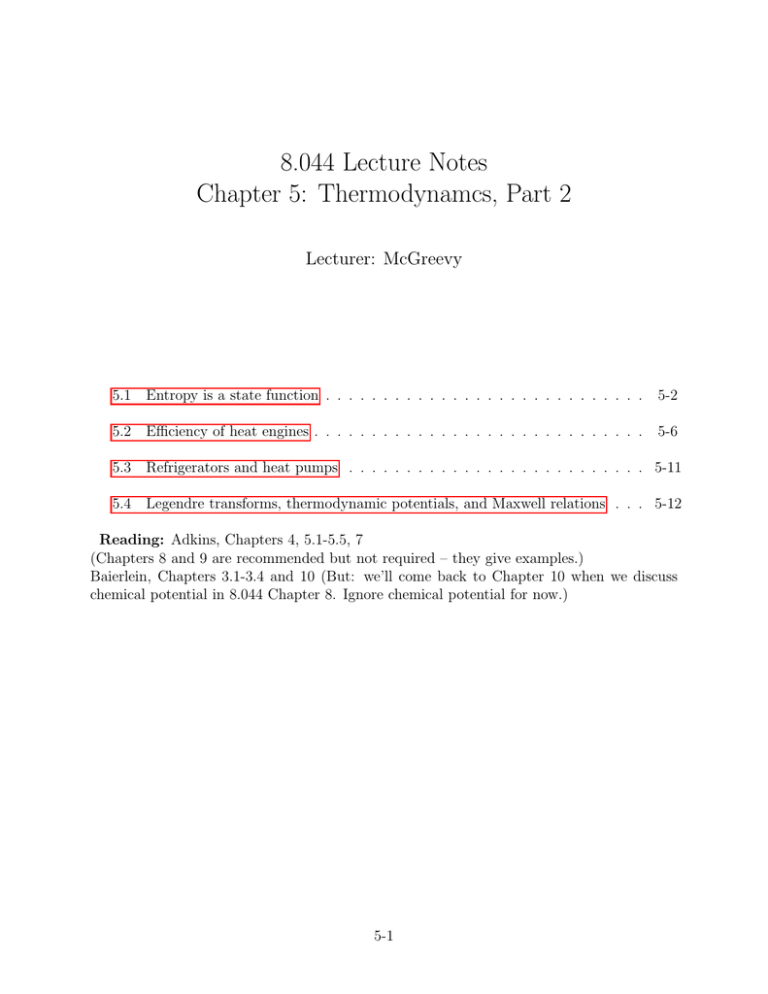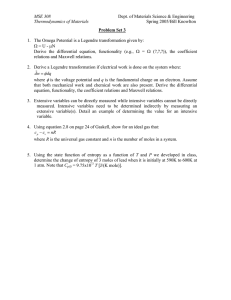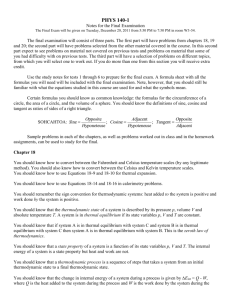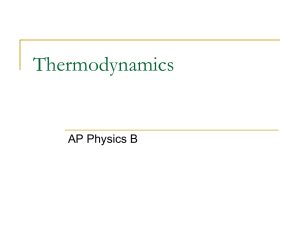8.044 Lecture Notes Chapter 5: Thermodynamcs, Part 2 Lecturer: McGreevy
advertisement

8.044 Lecture Notes
Chapter 5: Thermodynamcs, Part 2
Lecturer: McGreevy
5.1
Entropy is a state function . . . . . . . . . . . . . . . . . . . . . . . . . . . .
5-2
5.2
Efficiency of heat engines . . . . . . . . . . . . . . . . . . . . . . . . . . . . .
5-6
5.3
Refrigerators and heat pumps . . . . . . . . . . . . . . . . . . . . . . . . . . 5-11
5.4
Legendre transforms, thermodynamic potentials, and Maxwell relations . . . 5-12
Reading: Adkins, Chapters 4, 5.1-5.5, 7
(Chapters 8 and 9 are recommended but not required – they give examples.)
Baierlein, Chapters 3.1-3.4 and 10 (But: we’ll come back to Chapter 10 when we discuss
chemical potential in 8.044 Chapter 8. Ignore chemical potential for now.)
5-1
5.1
Entropy is a state function
This is a fact we know from the microscopic discussion in Chapter 4. Here we will illustrate
its thermodynamic consequences.
Example: Three different expansion processes for a hydrostatic
system
1) Free
2) Quasistatic Isothermal
3) Quasistatic Adiabatic
In each case, expand from e.g. Vi to Vf = 2Vi .
What is ∆S in each case?
1) Free expansion:
dS > dQ/T
¯
since it is not quasistatic.
In particular, ∆S > 0.
For an ideal gas,
E
V
3
S = kB N ln
+ ln
+ const
N
2
N
Recall: E does not change. Neither does N or T .
=⇒
Vf
Vf
Vi
∆S = kB N ln
− ln
= kB N ln
N
N
Vi
| {z }
=2
∆S = kB N ln 2 for free expansion
2) (Quasistatic) Isothermal expansion:
Isothermal means the temperature doesn’t change. Since the temperature didn’t
change in protocol (1) above, this is another way to get to the same final state.
But this time we’re getting there quasistatically, so dS = dQ/T
¯
.
5-2
Since T is constant and E = E(T ),
0 = dE = dQ
¯ + dW
¯
dQ
¯ = −¯
dW = +P dV
P
N kB
=⇒
dS = dV =
dV
T
V
Z f
Z Vf
dV
Vf
∆S =
dS = N kB
= N kB ln
V
Vi
Vi
i
=⇒
=⇒
Same answer:
∆S = kB N ln 2 for isothermal expansion
This had to be true in order for S to be a state function – it only depends on the
endpoints, not on how we got there.
3) Quasistatic adiabatic expansion:
dQ
¯
T
dQ
¯ = 0 =⇒ dS = 0.
quasistatic: =⇒
adiabatic: =⇒
dS =
∆S = 0 for quasistatic adiabatic expansion
Different final state means we can have a different ∆S.
V
E
3
S = kB N ln
+ ln
+ const
N
2
N
3
∆S = 0
=⇒
ln V + ln E = const
2
3/2
=⇒
V E = const
So if V increases by a factor of 2, E decreases by a factor of 22/3 . (Since E ∝ T , so
does T .)
Aside:
3
E = N kB T =⇒ V T 3/2 = const
2
P V = N kB T =⇒ const = V (P V )3/2 = P 3/2 V 5/2
=⇒ P V 5/3 = const
which is what we found before for the shape of an adiabat.
5-3
CP − CV for a general hydrostatic system.
Recall from Chapter 3 that:
∂U
CP − CV = |{z}
Vα
+P
∂V T
| {z }
=( ∂V
∂T )P
=0 for ideal gas
∂V
The reason α = V1 ∂T P has a name is that it is easy to measure. On the other hand, the
∂U
which was zero for ideal gas is not so easy to measure. (I guess we could imagine
term ∂V
T
doing adiabatic free expansion lots of times into different size containers.) We can use the
fact that entropy is a state function to find an alternate useful expression for it.
The fact that S is a state function means we can think of it as a function of any complete
set of independent thermodynamic variables. It started its life in our discussion as a function
of (E, V ), but S = S(T, V ) would work just as well.
∂S
∂S
dS =
dT +
dV
(1)
∂T V
∂V T
On the other hand, the 1st Law for quasistatic processes
dU = T
dS + −P
|{z}
| {zdV}
dQ
¯
dW
¯
also gives an expression for dS:
1
P
dU + dV
T
T
∂U
∂U
Use calculus on U : dU = ∂T V dT + ∂V T dV to get
1 ∂U
1
∂U
dS =
dT +
+ P dV
T ∂T V
T
∂V T
dS =
Now we can equate the coefficients in the two expressions, (1) and (2), for dS.
∂S
1 ∂U
∂U
∂S
=
= T1 ∂V
+P
∂V T
T
∂T V
T ∂T V
∂
∂
(
↑ )
=⇒
(
↑
)
=
∂T
∂V
The fact that S is a state variable means the mixed partials must be equal. This gives
1 ∂ 2U
1 ∂ 2U
1
∂U
1 ∂P
=
− 2
+P +
T ∂T ∂V
T ∂V ∂T
T
∂V T
T ∂T V
∂U
∂P
=⇒
+P =T
∂V T
∂T V
5-4
(2)
∂U
We’ve rewritten ∂V
in terms of things that are easier to measure – P and its derivatives.
T
To see that this is something nicely measurable we do one more manipulation:
We’ve shown that
∂P
CP − CV = V α T
∂T V
On the other hand, the reciprocity relation implies
∂P
−1
−1
α
= ∂V ∂T =
.
1 =
∂T V
κT
(−V κT ) V α
∂P T ∂V P
Since we can write it in terms of things that have historical names, it must be measurable.
CP − CV =
V T α2
κT
This expression (or its derivation) involves basically everything we’ve learned so far.
A few things we can deduce from it:
• We know that CP − CV ≥ 0. So consistency with this expression means κT > 0. (If
this is not true, the system will explode or collapse.)
• CP − CV = 0 if α = 0. That happens when ∂V
= 0.
∂T P
This happens for water at 4◦ C.
Aside: we’ve shown along the way here that
∂P
∂S
=
.
∂V T
∂T V
This is an example of a “Maxwell Relation”. (A different kind of
Maxwell relations are shown at right.) There are actually more of
them, and we’ll derive them systematically soon in §5.4.
5-5
5.2
Efficiency of heat engines
Recall:
hot source
1. A heat engine takes a system (some assembly of some substance)
around a closed cycle over and over. It returns to the initial state
after one cycle.
2. Heat is transferred into and out of the substance. Some part of
the cycle involves a cold sink.
Conventions:
QH is the heat taken in from the hot reservoir.
QC is the heat spat out to the cold sink.
WOU T is the work done by the system.
QH
engine
QC
cold sink
3. Work is performed.
4. Efficiency is a subjective thing, in that it is defined as the ratio
of (what we want) to (what we use up) – it depends on our goals.
For heat engines, efficiency is defined by
η≡
Wout
QC
work out
=
=1−
heat in from hot source
QH
QH
If all of QH enters from a reservoir at a single TH , and
if all of QC exits to a reservoir at a single TC , and
if the engine operates quasistatically
then this is called a Carnot engine.1 Then the following is true:
Carnot: ∆SH =
QH
TH
∆SC = −
QC
TC
where ∆SH is the change in entropy of the system during the heating stage of the cycle and
∆SH is the change in entropy of the system during the cooling stage of the cycle. When we
heat the system, we increase its entropy; when we extract heat, we decrease its entropy.
1
Below we will consider more complicated things, e.g. more isothermal legs and more adiabatic legs. They
will compare unfavorably with Carnot.
5-6
WOUT
S is a state function, and we are going in a closed cycle, so during one whole cycle:
0 = ∆STOT .
Finally, if we assume quasistatic operation, then the adiabatic legs involve no change in
entropy:
0 = dQ
¯ = T dS
for adiabatic steps.
So:
QH
QC
−
TC
TH
QC
QH
=⇒
=
TC
TH
0 = ∆ST OT =
=⇒
η =1−
TC
.
TH
There can be many implementations of such a Carnot engine: e.g. one where the substance
in question was an ideal gas, or one involving a paramagnet. They all look the same on a
T-S diagram:
T
1
TH
Q H in
S1
S2
TC
2
4
Q C out
3
S
The P-V diagram and the H-M diagram would look quite different from each other:
5-7
If everything is done quasistatically
I
=
T dS
| {z }
I
dQ
¯ = QH − QC
1st Law
=
WOU T
=area enclosed in TS diagram
On the other hand, S is a state function means that
I
I
dQ
¯
quasistatic
0=
dS
=
T
any closed cycle
If the cycle is not traversed quasistatically,
dQ
¯
dS >
T
I
dQ
¯
≤0
T
I
=⇒
dQ
¯
<0
T
Clausius’ Theorem
and the inequality is saturated for quasistatic cyclic processes ( = Carnot engines).
5-8
Carnot is the best
Two arguments that Carnot efficiency is the maximum possible:
Consider a cyclic but not quasistatic engine which takes heat from some reservoir at TH
and dumping into a cold sink at TC , just like the engine we just studied.
hot source, T
TH
H
QH
QH ’
W OUT
other
Carnot,
running
backwards
engine
Q −Q ’
H
=
Q C’
QC
cold sink, T
H
Q −Q ’
C
T
C
C
C
Clausius’ Statement of 2nd Law: QH − Q0H ≥ 0 =⇒ QH ≥ Q0H . (Similarly for QC ≥ Q0C .)
=⇒
WOU T
WOU T
≤
QH
Q0H
=⇒ ηother engine ≤ ηcarnot engine .
5-9
Carnot is the best, part 2
Q: Can we do better if we construct some complicated protocol involving reservoirs at
different temperatures?
Consider the cycle of an arbitrary, quasistatic engine in the TS plane:
η=
Z
QIN =
W
QIN − QOU T
QOU T
=
=1−
.
QIN
QIN
QIN
Z 2
T dS ≤ Tmax
dS = Tmax (S2 − S1 ) .
upper path from 1 to 2
Z
1
Z
QOU T = −
Z
T dS ≥ Tmin
T dS = +
lower path from 2 to 1
lower path from 1 to 2
2
dS = Tmin (S2 − S1 ) .
1
These facts combine to imply that
η =1−
QOU T
Tmin (S2 − S1 )
Tmin
=1−
≤1−
= ηCarnot
QIN
Tmax (S2 − S1 )
Tmax
It is less than the efficiency of a Carnot engine with just two reservoirs, one at Tmin and one
at Tmax .
A: No.
[End of Lecture 13.]
5-10
5.3
Refrigerators and heat pumps
Refrigerator: run the cycle backwards, extract heat at the cold end and
dump heat into the hot reservoir. Accomplishing this requires that we
do work on the system, QH = W + QC .
Assume that this is a Carnot refrigerator, i.e. everything is reversible,
and there’s just two temperatures involved TH , TC .
We know:
TC
W
=1−
,
QH
TH
For
TH
TC
H
QH
W
refrigerator
QC
TC
=
QH
TH
QC
but this isn’t what we care about in judging whether this is a good
refrigerator.
ηrefrig =
T
T
C
what we want
heat extracted from cold end
QC
QC
TC
=
=
=
=
what we use up
work done on system
W
QH − QC
TH − TC
= 1+ a little, ηrefrig 1 – easy to cool without doing a lot of work, low power.
For TC → 0, ηrefrig → 0. It becomes increasingly difficult to cool something as T → 0.
T = 0 is the point at which no further heat can be extracted.
Reaching T = 0 requires an infinite amount of work.
Heat Pump
Same setup, but with a different goal.
Suppose we want to heat the hot end, not cool the cold end.
ηheat pump ≡
QH
QH
=
W
QH − QC
if reversible
=
Now we have completed the rigorous version of Chapter 1.
Go back and read Chapter 1 again.
One more item in thermodynamics, however:
5-11
TH
TH − TC
5.4
Legendre transforms, thermodynamic potentials, and Maxwell
relations
A while back, we saw that we could start with2
E = E(S, V )
in terms of which the 1st Law for quasistatic processes is:
dE = T dS − P dV
and from this construct a new state variable:
H ≡ E + PV
enthalpy
dH = dE + P dV + V dP =⇒ dH = T dS + V dP
(3)
Note then that the enthalpy H is most naturally H(S, P ). It is most useful in analyzing
processes at constant pressure, in which case (3) reduces to
dH = dQ
¯
(this is true even if the process is not quasistatic).
E and H are two examples of thermodynamic potentials.
The step of going from E(S, V ) to H(S, P ) is an example of a Legendre Transform.
A place where you might have seen this operation is going between Lagrangian and Hamiltonian descriptions in classical mechanics.
As there, the same physics can be described using E or H. Sometimes one is more convenient than the other. For example:
CV = ∂E
CP = complicated expression with derivs of E
∂T V
∂H
CV = complicated expression with derivs of H
CP =
∂T P
2
We wrote it as U = U (S, V ); if you like, this is the relation S = S(U, V ), rearranged by solving for the
internal energy.
5-12
A mathematical interlude on Legendre Transform
Consider a function y(x) whose second derivative y 00 (x) is nowhere zero.
(So it is everywhere concave, or everywhere convex.)
[ Think of E = E(V ) at fixed S: E = 32 N kB T, V T 3/2 = const =⇒
E(V, S) ∝ V −2/3 . ]
Geometric interpretation:
Consider the point (x, y) = (x, y(x)) along the curve y(x); draw the
tangent line through this point. It has slope y 0 = y 0 (x). Its y-axisintercept is at
I ≡ y − xy 0 .
We can represent the information about the same curve as either y(x) or as I(y 0 ). Here’s
the protocol for doing the latter:
Pick a y 0 . Draw a line with that slope. Slide it up and down until it has intercept I(y 0 ).
Repeat for however many values of y 0 you want.
This collection of straight lines (determined by I(y 0 )) is the “envelope of tangents” of the
curve of interest y(x).
y(x) ↔ I(y 0 )
Contain the same information, determine the same curve.
5-13
In the definition of I ≡ y − xy 0 , you recognize the formula for Legendre transformation.
Rewrite in terms of thermo letters:
y(x) →
(S,
E
|{z}
V
|{z}
)
think of this as x
think of this as y
and S is just a spectator.
0
y =
∂E
∂V
= −P.
S
I ( y 0 ) = y − xy 0 = E + P V = H(S, P ).
|{z}
|{z}
H
−P
So E(S, V ) and H(S, P ) describe the same physics.
3
Now we can Legendre transform back:
In the plot I have shown the curve I(y 0 ).4 Also indicated are the point (y 0 , I) and the
vertical-axis-intercept of the tangent through that point. Its height is
I − y0
3
4
∂I
˜
≡ I.
∂y
As long as E is a convex (or concave) function of V . This is in fact a requirement for stability.
I’m using the I(y 0 ) for the function I plotted above, which was y(x) = (x − 2)2 − 2. This means
y 0 (x) = 2(x − 2) ;
I solved this for x(y 0 ) = (4 + y 0 )/2 and plugged that into
I(y 0 ) = y(x) − xy 0 = 2 − 2y 0 − (y 0 )2 /4.
5-14
˜ ∂I ). But
We can represent the data in I(y 0 ) just as well by I(
∂y
∂I
= −x
∂y 0
=⇒ I˜ = I + xy 0 = y
That is, I˜ = y(x). So the Legendre transform squares to one, i.e. undoes itself.
Returning to physics variables again, start with H(S, P ) and dH = T dS + V dP . Construct
E = H − PV .
dE = T dS − P dV
So this is E(S, V ).
So to go back and forth between E and H we Legendre transform, either way.
Maxwell Relations
=⇒
∂E
∂S
=T
V
dE = T dS − P dV
∂E
= −P
∂V S
dH = T dS + V dP
∂H
=⇒
=T
∂S P
E is a state variable.
equate mixed partials of E:
∂P
∂T
=−
=⇒
∂V S
∂S V
∂H
∂P
=V
S
H is a state variable.
equate mixed partials of H:
∂V
∂T
=
=⇒
∂P S
∂S P
So: Maxwell Relations follow by equating mixed second derivatives of thermodynamic potentials. The second one is the one we encountered previously.
5-15
More thermodynamic potentials → more Maxwell relations
So far S has just gone along for the ride in our Legendre transforms: we haven’t touched
the T dS bit. We can Legendre transform that bit, too:
Define
F = E − TS
“(Helmholtz) Free Energy”
(Mnemonic: ‘F’ is for ‘free’.)
dF = dE − T dS − SdT
dF = −SdT − P dV
=⇒
So F = F (T, V ).
[Preview: in the next Chapter, we will formulate statistical mechanics for a system which
is not isolated, and in particular is held at constant temperature by a heat reservoir. F will
play a key role.]
From this expression, we deduce:
∂F
= −S
∂T V
∂F
∂V
= −P
T
Equating crossed derivatives gives our 3rd Maxwell relation:
∂S
∂V
=
T
5-16
∂P
∂T
V
The 4th Maxwell relation, by the Method of the Missing Box
E = E(S, V ),
dE
= T dS
−P
dV,
∂P
∂T
= −
∂V S
∂S V
H = E + PV
.
&
F = F (T, V ),
dF
= −SdT
−P dV,
∂S
∂P
−
= −
∂V T
∂T V
H = H(S, P ),
dH
dS +
= T
V dP
∂T
∂V
=
∂P S
∂S P
G = H − ST
F = E − TS
&
.
G = F + PV
G = G(T, P ),
dG = −SdT+ V dP,
∂S
∂V
−
=
∂P T
∂T S
G is for “Gibbs’ Free Energy”. The 4th and last thermodynamic potential (for a hydrostatic
system): E, F, G, H.
You should be able to quickly recreate this derivation of the four Maxwell relations.
DO NOT MEMORIZE THIS STUFF.
Note that you can do this operation for any pair of conjugate variables. In systems with
more thermodynamic variables, there are more thermodynamic potentials. For example in
a system with a magnetization, E = E(S, V, M ) so
dE = T dS − P dV + HdM
and we can construct a new thermodynamic potential whose name is not standard:
I = I(S, V, H) ≡ E − HM
for which
dI = T dS − P dV − M dH.
5-17
Conditions for equilibrium (The point of F and G, and why they are called ‘free’
energies.)
1. Consider a system in contact with a bath at temperature T . Suppose the system is
equilibrating at constant V .
dQ
¯
.
As it equilibrates, the 2nd Law tells us: dS ≥
Tbath
Since V is constant, dV = 0 =⇒ dW
¯ = 0 so the 1st Law is: dE = dQ:
¯
dS ≥
dE
Tbath
=⇒ d (E − Tbath S) ≤ 0
dF ≤ 0
at constant V, Tbath
So: at constant V, T , the system evolves so as to minimize F .
2. Suppose instead that work can be done, dV 6= 0, as the system equilibrates, but P is
held constant.
dQ
¯
dE + P dV
dS ≥
=
Tbath
Tbath
!
=⇒ d E − Tbath S +
P
|{z}
V
assumed constant
=⇒ dG ≤ 0
at constant P, Tbath
So: at constant P, T , the system evolves so as to minimize G.
Note also that at fixed P ,
d (E − T S) ≤ −P dV
=⇒ dF ≤ +¯
dW
=⇒ −dF ≥ −¯
dW
−¯
dW is the work done by the system.
During relaxation to equilibrium at constant T and P , the work done by the system is
less than or equal to the (magnitude of the) change in F , as F decreases.
This is why F is called the ‘Free Energy’ or ‘available energy’.
This is all the thermodynamics we’re going to need, except for Chapter 8: Chemical Potential.
Next: the version of Stat Mech that we actually use.
5-18







